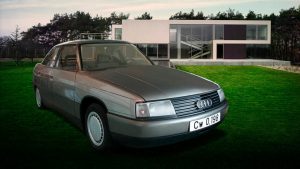Design from Zagato, Japanese salon and someone else’s index: myths and facts about the VAZ-2110
 Among the many models with a difficult fate, developed in Soviet times, the “pregnant antelope” stands alone. After all, the “ten” was for many the long-awaited model of the VAZ, which finally received a “foreign-made” design and a powerful 16-valve engine, which allowed it to compete at the beginning of the zero with an equal to 10-15 year old “Europeans” and “Japanese. But at the same time, for thousands of owners and just admirers of the VAZ-2110, much of the history associated with the development of this car “remained off-screen.” The lack of information already in our century, “forum experts” was often compensated by funny pseudo-facts, supported by their own “investigations”. Today we will try to shed some light on the features of the birth of this car, which never got its own name, but forever remained the “top ten”.
Among the many models with a difficult fate, developed in Soviet times, the “pregnant antelope” stands alone. After all, the “ten” was for many the long-awaited model of the VAZ, which finally received a “foreign-made” design and a powerful 16-valve engine, which allowed it to compete at the beginning of the zero with an equal to 10-15 year old “Europeans” and “Japanese. But at the same time, for thousands of owners and just admirers of the VAZ-2110, much of the history associated with the development of this car “remained off-screen.” The lack of information already in our century, “forum experts” was often compensated by funny pseudo-facts, supported by their own “investigations”. Today we will try to shed some light on the features of the birth of this car, which never got its own name, but forever remained the “top ten”.
Soviet designers were repeatedly accused of copying foreign cars – for example, in the case of AZLK-2141, the resemblance to the French Simca 1308 was obvious. And since the VAZ-2110 with its “duto-candy” design was radically different from both the brick-like Zhiguli and the angular “chisel”, some recognized “foreign legs” in the origin of the Soviet-Russian novelty. Audi 80 B3, Volkswagen Passat B3 and even (partially) Saab 900 of the second generation – in all these models skeptics saw the basis of the “dozens”. Moreover, at the suggestion of the foreign edition of “Wheels” (wheels!), Even in the early stages of working on prototypes of the VAZ-2110, such exotic things as the Italian bodybuilding studio Zagato were called as possible “contractors”!
Sketches of the future: aerodynamic shields on wheels clearly show how designers wanted to improve streamlining of the body of the “dozens”
Everything was different and simpler: many decisions in the design of “pregnant antelope” are explained by the desire to achieve the best aerodynamics. Soviet designers and engineers had their own motives – for example, to provide the car with the best dynamic qualities with the same engine power as the previous front wheel drive. Therefore, “licking” the body with soft transitions and the lack of protruding elements such as wheel arches and gutters was inevitable, as well as a “barrel-shaped” silhouette, in which many saw the Audi 80 or Passat B3.
We offer readers using these photos to independently answer the question whether the VAZ-2110 was “licked” from the Passat
Yes, in 1986, designers came across “live” with the newest Passat in the USSR at the Dmitrov proving ground, where the “Be-the-third” together with the VW Scirocco got into winter trials. Yes, the “dozens” wooden mockup was blown through the Porsche wind tunnel and compared with the “barrel” for clarity. However, the general proportions of the body and the individual solutions (for example, door frames) on the “top ten” and Audi differed so much that it is impossible to talk about direct borrowing.
However, the one who searches for “alien blood” will find it: in 1984, the Audi 80 Cw-Studie Concept was created in a single copy, which became the prototype of the “barrel” B3. And here in his appearance, if desired, you can find some elements embodied in the serial VAZ-2110.
Closer: the shape of the front bumper, the wheel arches and the Audi 80 Cw-Studie Concept are really the same as on the VAZ-2110
VW Auto 2000 – so Volkswagen saw the “car of the year 2000” in 1982. It easily identifies the future Passat B3
In the eighties, at the AvtoVAZ, they took up the project of a new “classic”, while simultaneously working on a version of the sedan on a platform ready for launch into production of the VAZ-2108 hatchback. In parallel, over the fundamentally new generation of Zhiguli and the four-door Sputnik, work was carried out until about 1985. Soon the classics decided to abandon the idea of deep modernization, too much needed to be changed and even redone. Therefore, the rear-wheel drive VAZ-2112 remained at the stage of design projects, but the “ten-sedan” had to stand on a separate line of the conveyor shortly after the release of the five-door VAZ-2109.
This layout of the Satellite-sedan is VAZ-2110 index is not at all by mistake.
But the restructuring that began, with the subsequent lack of funds to finance new developments, effectively put an end to the rapid and successful launch of a promising model on the second production line. And then the factory decided to modify the welding equipment so that, together with front-wheel drive hatchbacks, it was possible to manufacture the body for sedans. Well, the “additional” index of the VAZ-21099 was called not just like that – so that the launch of the sedan into mass production turned out to be faster, Samara was officially positioned to start positioning not as a completely new model, but as a modification of “zero ninth”. This trick allowed the car to pass in 1988 not a full cycle of acceptance tests, but a simplified state acceptance, which was allowed for modifications.





